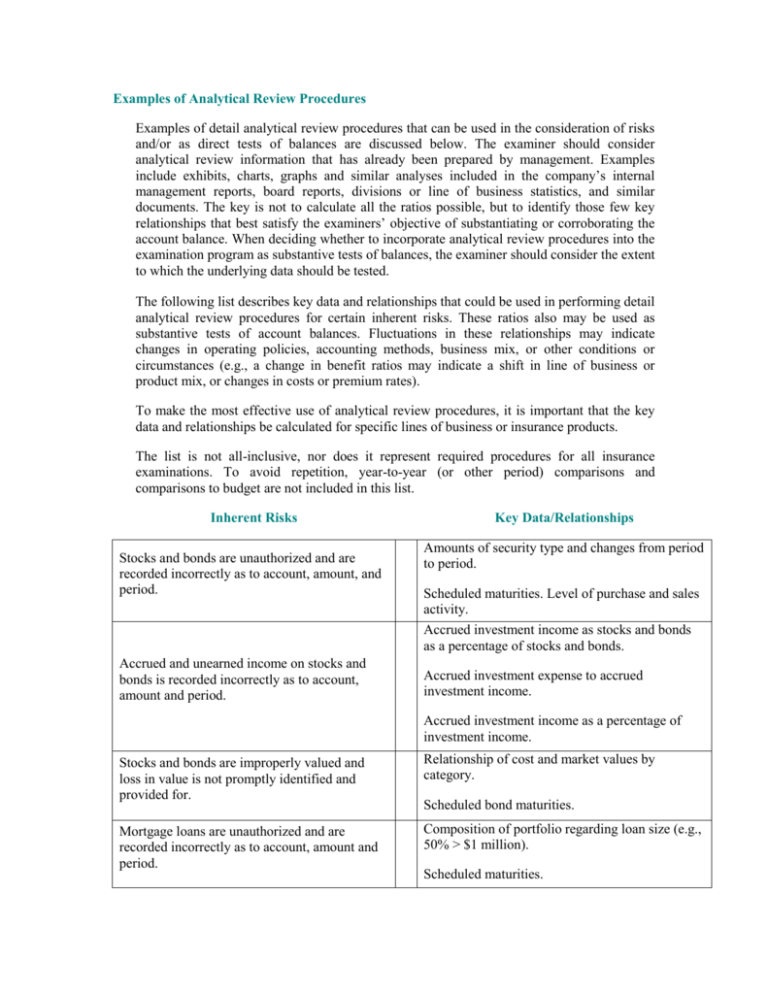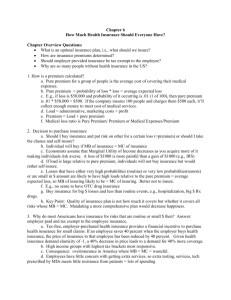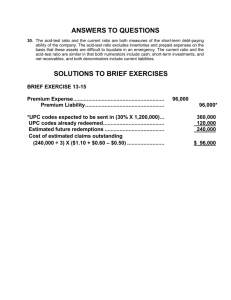Examples of Analytical Review Procedures
advertisement

Examples of Analytical Review Procedures Examples of detail analytical review procedures that can be used in the consideration of risks and/or as direct tests of balances are discussed below. The examiner should consider analytical review information that has already been prepared by management. Examples include exhibits, charts, graphs and similar analyses included in the company’s internal management reports, board reports, divisions or line of business statistics, and similar documents. The key is not to calculate all the ratios possible, but to identify those few key relationships that best satisfy the examiners’ objective of substantiating or corroborating the account balance. When deciding whether to incorporate analytical review procedures into the examination program as substantive tests of balances, the examiner should consider the extent to which the underlying data should be tested. The following list describes key data and relationships that could be used in performing detail analytical review procedures for certain inherent risks. These ratios also may be used as substantive tests of account balances. Fluctuations in these relationships may indicate changes in operating policies, accounting methods, business mix, or other conditions or circumstances (e.g., a change in benefit ratios may indicate a shift in line of business or product mix, or changes in costs or premium rates). To make the most effective use of analytical review procedures, it is important that the key data and relationships be calculated for specific lines of business or insurance products. The list is not all-inclusive, nor does it represent required procedures for all insurance examinations. To avoid repetition, year-to-year (or other period) comparisons and comparisons to budget are not included in this list. Inherent Risks Stocks and bonds are unauthorized and are recorded incorrectly as to account, amount, and period. Accrued and unearned income on stocks and bonds is recorded incorrectly as to account, amount and period. Key Data/Relationships Amounts of security type and changes from period to period. Scheduled maturities. Level of purchase and sales activity. Accrued investment income as stocks and bonds as a percentage of stocks and bonds. Accrued investment expense to accrued investment income. Accrued investment income as a percentage of investment income. Stocks and bonds are improperly valued and loss in value is not promptly identified and provided for. Relationship of cost and market values by category. Mortgage loans are unauthorized and are recorded incorrectly as to account, amount and period. Composition of portfolio regarding loan size (e.g., 50% > $1 million). Scheduled bond maturities. Scheduled maturities. Inherent Risks Accrued and unearned income on mortgage loans is recorded incorrectly as to account, amount and period. Key Data/Relationships Accrued income as a percent of total portfolio. Accrued income on mortgage loans as a percent of total investment income. Mortgage loans are improperly valued and admitted and loss in value is not promptly identified and provided for. Ratio of nonadmitted loans to total loan portfolio. Real estate holdings are unauthorized and are improperly recorded as to account, amount and period. Real estate to total investments. Accrued expense to accrued income. Accrued and unearned income on real estate holding is recorded incorrectly as to account, amount and period. Accrued income to total real estate portfolio. Accrued income from real estate as a percentage of total investment income. Real estate holdings are not protected by insurance and any loss in value is not promptly identified and provided for. Loss to total portfolio - Insurance proceeds from losses to book value - Insurance policy face value to book value. Policy loans are unauthorized and are recorded incorrectly as to account, amount and period. Policy loan balances to total investments - Policy loan balance to total cash value of policies inforce. Accrued and unearned policy loan income is recorded incorrectly as to account, amount and period. Policy loans are improperly valued and nonadmitted assets are not promptly identified and provided for. Accrued interest on policy loans to total policy loans. Accrued interest on policy loans to total investment income. Overloans to total policy loans. Scheduled maturity dates. Short-term investments are unauthorized, improperly valued and recorded incorrectly as to account, amount and period. Short-term investments to total investments. Composition of short-term investments (e.g., CDs are 50%). Inherent Risks Accrued and unearned income on short-term investments is improperly recorded as to account, amount and period. Other assets are improperly valued and recorded incorrectly as to account, amount and period. Key Data/Relationships Accrued interest on short-term investments to total short-term investments. Accrued interest on short-term investments to total investment income. Amortization/depreciation to asset cost. Reinsurance premiums assumed to premium income. Reinsurance assumed and ceded transactions are unauthorized and recorded incorrectly as to account, amount and period. Provisions for income taxes and related assets and liabilities are recorded incorrectly as to account, amount and period. Due, deferred and advance premiums are calculated incorrectly and not recorded properly as to account, amount and period. Life policy benefit reserves are incomplete and are recorded incorrectly as to account, amount and period. Reinsurance premiums ceded to premium income. Comparison of assumed and ceded in-force in total and by line to total in-force and to prior periods. Income tax provision to pre-tax income. Due and deferred premiums to total premiums. Advance premiums to total premiums. Increase in reserves to premium income. Reserves per $1,000 of in-force by line of business. Net premiums to gross premiums. Policies with deficiency reserve situations are not identified or properly provided for. Accident and health reserves are calculated and recorded incorrectly as to account, amount and period. Loss ratios and results of operations for A&H and credit business. Unearned premiums to written premiums. Reserves per $1,000 of in-force. Other reserves and policy liabilities are incomplete and are not recorded properly as to account, amount and period. Credit unearned premiums per $1,000 of life and indemnity in-force. Increase in reserves to premium income. Inherent Risks Key Data/Relationships Numbers and total amounts of due and unpaid and in course of settlement claims. Claim liabilities are incomplete and unreasonable and are recorded incorrectly as to account, amount and period. Due and unpaid and in course of settlement amount to total claim reserves. Average claim reserves to average benefit payment amount. Accrued salary-to-salary expense. Other liabilities are incomplete and unreasonable and are not recorded properly as to account, amount and period. Accrued commission-to-commission expense. Accrued salary per employee. Total other accruals to total other expenses. Remittances and unallocated items are unreasonable and not current. Total suspense account to premium income. Borrowed money is unauthorized and not recorded properly as to account, amount and period. Interest expense to average borrowing rate by outstanding debt. H. Operating Results – Life and A&H Life and A&H premium revenues change as a result of changes in premium rates, volume of risks insured, and extent of coverage per risk insured. Life insurance benefits paid change primarily because of better-or-worse-than expected mortality or surrender experience. A&H loss ratios change as a result of changes in both the incidence and severity of claims. One measure of life and A&H operating results is the relationship of benefits paid and provided to premium income. Benefits paid and provided can be broken down into various components, depending on the line of business involved. For ordinary life and A&H, these components can be (1) increases in reserves as a percent of premiums and (2) claims incurred as a percent of premiums. Credit life and A&H business is measured by the ratio of claims incurred to premiums earned. Group life and A&H insurance also are measured by this ratio. Several analytical ratios and relationships can be used to measure the operating results of life and A&H insurance. The ratios and relationships should be prepared by line of business and compared with prior years and, if available, comparable industry data. Examples of some of the more common ratios and relationships include: Life Insurance 1. Prior year total premiums to current year renewal premiums 2. Average first-year premiums per policy to average renewal premiums for flexible premium and universal life business 3. Benefits paid or provided to premium income 4. Claims incurred to premium income 5. Cash surrender expense to premium income 6. Policyholder dividends to participating premium income and income before dividends to policyholders 7. Commission expense to premium income, by first year and renewal business 8. General and administrative expenses to premium income 9. Premium taxes to premium income 10. Investment income to total income 11. Investment expenses to investment income A&H Insurance 1. Benefits paid or provided to premium income 2. Benefits paid or provided to prior year reserves 3. Increase in reserves to premium income 4. Claims incurred to premium income 5. Commission expense to premium income 6. General and administrative expenses to premium income 7. Premium taxes to premium income 8. Investment income to total income 9. Investment expenses to investment income Policy Benefits Reserves In addition to the various ratios and relationships that may be used to analyze operating results, various carry forward schedules and comparative analyses can be used as direct tests of balances or to help support the reasonableness of ordinary life and annuity benefit reserves. Some of the most common ratios and relationships include: 1. Reserves per $1,000 of in force by line of business and/or significant product; 2. Dividend expense per $1,000 of participating in force by line of business and/or significant product. 3. Claim Reserves In addition to the various ratios that may be used to analyze operating results, the following relationships may be used to help support the reasonableness of A&H claim reserves. 1. Claim reserves (current year to prior years) 2. Claim reserves to premium income or annualized premiums 3. Claim incurred to claim reserves 4. Average claim reserves (current year to prior years) 5. Average paid claim severity (current year to prior years) 6. Average paid claim severity to average claim reserves (year-to-year changes in this ratio measure whether reserve level increases correspond to current severity increases) 7. Historical development of the adequacy of claim reserves Underwriting Results – Property/Casualty A commonly used measurement of property/casualty underwriting results is the “combined ratio,” that is, the ratio of losses, loss adjustment expenses and underwriting expenses to premiums. (All general and administrative expenses, other than those allocated to investment operations, are considered underwriting expenses.) The combined ratio is further broken down into two components – the loss ratio and the underwriting expense ratio. The loss ratio includes both losses and loss adjustment expense as a percentage of premiums earned. The underwriting expense ratio is underwriting expenses incurred to premiums earned. On a statutory basis, the expense ratio is statutory underwriting expenses incurred to premiums written. GAAP and statutory underwriting expenses differ in that under GAAP, acquisition expenses are deferred and amortized as the related premiums are earned. Under statutory accounting, acquisition expenses are charged as expenses when incurred. Loss Ratios The loss ratio changes from period to period because of changes in the relationship between losses and premiums. Losses change as a result of changes in exposures, frequency and severity-of-loss occurrences. Changes in loss adjustment expense levels also affect the loss ratio. Premiums change because of changes in premium rates, in the volume of risks insured and in the extent of exposure per risk insured. Several analytical relationships exist between losses and premiums and their components. The examiner should make an effort to obtain these statistics by accident year, if available, to eliminate the distortion of revisions in reserve estimates of prior years. These analytical relationships include: 1. Number of claims reported to number of earned exposure units. (This relationship measures loss frequency. For many lines of business, a suitable basis for measuring earned exposure units may not exist. For these lines of business, some other suitable measure of exposure may be substituted). An “exposure unit” is generally defined as the subject of the insurance coverage. For example, in the case of auto insurance, the exposure unit would be a vehicle or automobile that presents certain risks to the automobile’s owner, which risks are mitigated by, among other means, procuring insurance coverage. An “earned exposure unit” is an exposure unit for which coverage is in force for an entire policy year. If a policy is in force for only a fractional year, a fractional earned exposure unit would be recorded, based on the portion of the year the policy is in force. When premiums are stated on a unit basis, the effects of changes in premium rates are eliminated, and exposure is presented on a comparable basis. However, a reasonable unit measure of exposure does not exist for many lines of business. 2. Average premiums written or earned per policy or per exposure unit. 3. In force policies stratified by policy limits. (This is a useful indicator of changing levels of exposure for lines of business for which the calculation can be made.) 4. Historical loss development data. (This provides information as to whether the company has historically provided adequate reserves for losses; it can be useful in evaluating the adequacy of current reserves. However, the data is useful only when proper consideration is given to current circumstances affecting loss reserves (e.g., premium rate increases, changes in policy coverage, inflation, etc.). 5. Losses incurred per earned exposure unit. (This relationship measures the “pure premium,” the portion of the premium required to cover losses. Again, exposure unit data may not be available for all lines of business.) 6. Average loss reserve. (When related to average loss reserves in prior periods, this ratio serves as a current measure of comparative loss reserve adequacy.) 7. Average paid claim severity. 8. Average paid claim severity to average loss reserve. (On a comparative basis, this ratio measures whether reserve level increases have corresponded with current paid severity increases.) 9. Losses incurred to loss reserves. (This ratio measures how rapidly loss reserve levels are changing in relation to loss volume.) 10. IBNR loss reserves to various measures of exposure to loss (premiums earned, exposure units earned, premiums written, premiums in force, losses incurred, claims reported, etc.). The ratio measures comparative IBNR reserve adequacy. 11. Loss Adjustment Expense (LAE) reserves to loss reserves. 12. Allocated LAE paid to losses paid. 13. Unallocated LAE paid to losses paid. These relationships can provide some indication of the adequacy of loss reserves. If these relationships are reasonable in view of the examiner’s expectations, the extent of loss reserve projections may be minimized. Further, the results of these detail analytical review procedures may aid in the selection of reserve projection methods for direct tests of the reserves (e.g., severity projection method may be selected if average severity shows large fluctuations). Underwriting Expense Ratios The underwriting expense ratios change from period to period because of a change in the relationship between underwriting expenses and premiums. A significant portion of underwriting expenses is made up of costs that vary directly with premiums (e.g., commissions and premium taxes). Other costs, principally salaries, may be fixed or semifixed. The ratio of these other costs to premiums may also vary as premium levels fluctuate. Various analytical ratios can be used to review the reasonableness of the relationships between underwriting expenses and written, earned and unearned premiums. These include: Commissions to premiums. (This ratio can be measured based on either statutory commission expense to premiums written or GAAP commission expense to premiums earned. For most companies, separate calculations of this ratio should be made by line of business for direct, assumed, and ceded business.) Commissions netted against agents’ balances to gross agents’ balances. (Agents’ balances are recorded net of the related commissions due to the agents. The amount of commissions netted, if available, should be compared to the grossed-up amount of agents’ balances. The resulting ratio should be compared to the ratio of commission expense to premiums.) Premium taxes to premiums written. (This ratio is a measure of statutory premium tax expense to premiums written. In the absence of a significant shift in the mix of business or in premium tax rates or taxability, this ratio should be quite stable from period to period.) Unearned premium reserve to in-force premiums and unearned premium reserve to written premiums. (These ratios are measures of the unexpired portion of premiums to total premium volume.) Four other ratios relate to underwriting and, more specifically, to premiums receivable or agents’ balances: Agents’ or premium balances charged off to premiums written; Agents’ or premium balances charged off to premiums earned; Premium or agent receivables to in-force premiums; and Aging of premium or agent receivables. (These ratios will take on varying significance in different situations. Often, premium collection problems and bad debts are minimal because premiums are collected in advance of providing the policy coverage. However, if an insured has paid the premium to an agent of the company, the company must provide coverage even if the agent does not transmit premiums to the company. Therefore, the reliability of agents is of concern.) Reinsurance For companies that assume significant amounts of reinsurance, analytical schedules that summarize significant balance sheet and income statement accounts by each major treaty allow analysis of the underwriting results assumed under each major treaty. Their results should be compared with expectations developed through an understanding of the related treaty and environmental considerations. Investments In addition to various ratios that may be used to analyze operating results, the following ratios may be used to measure investment operations: 1. Individual investment asset categories to total assets. (These relationships can be an important indicator of a company’s investment philosophy and liquidity, and a key to evaluating a company’s compliance with statutory investment limitations.) 2. Investment yield – in total and by investment category. (This ratio can be based on investment income to average invested assets, in total and by investment category. This ratio can be an important indicator of profit margins on interest-sensitive products and an overall indicator of investment performance.) 3. Bond maturity schedule. (This may be an important indicator of liquidity – especially for companies in a weak cash flow position.) Ratio of market-to-book value of stocks. (This is basically a measure of stock market performance. When the ratio differs from expectations based on overall market trends, further investigation is warranted.)








